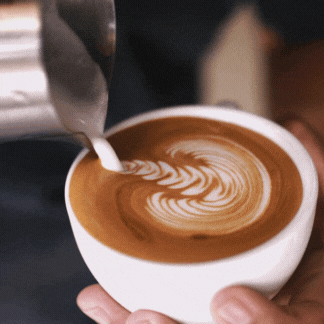
I spent an entire day researching what is a latte, and then I summarized the main things you need to know.
By the end of this article, you’ll know exactly where the latte came from and how it evolved over the years. There’s also a recipe at the end to make a latte yourself!
Origins
In the 1650s, coffee took England by storm. It was exhilarating, exotic, and if you could afford to drink it, it was the thing to serve at social gatherings. Raw, undiluted coffee, however, often proved to be a bit too strong for the uninitiated coffee drinker.
Enter the latte. Tradition attributes its origin to America, but history tells another story. The latte was found in France as early as the 17th century, where it was dubbed café au lait, or to the native French, café crème.
Then in the 1860s, this milky drink was introduced to regions of Italy frequented by American tourists. They called it the caffè latte. With its richer, creamier, and milder taste, the latte appealed more to these tourists than it did to native coffee drinkers.
The latte didn’t take off in North America until the 20th century, when it finally crossed the proverbial pond. Americans’ balking at too-strong coffee finally brought the caffè latte home.
But what is in a latte, and what is a latte made of?
What is a Latte Made Of?
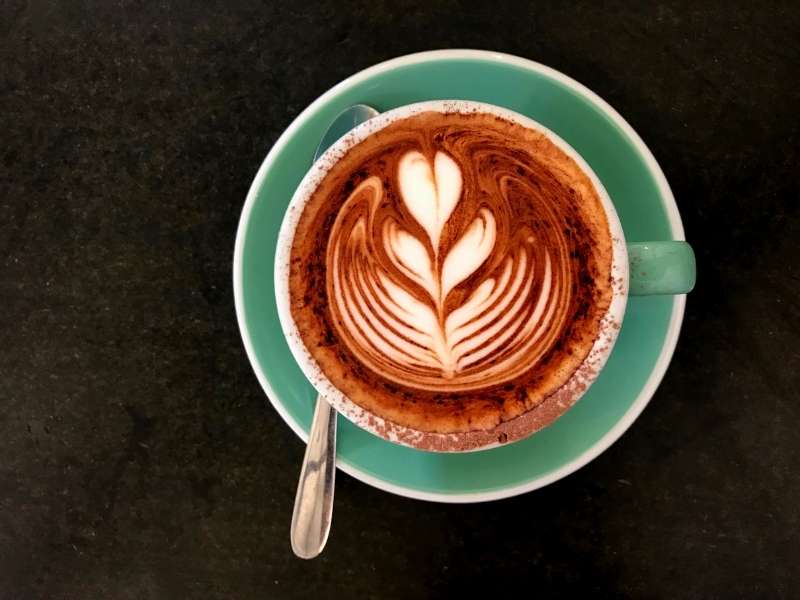
The word latte literally means milk in Italian. So as you’ve probably guessed, a key part of the Latte is steamed milk.
The other crucial ingredient when making a Latte is espresso. Espresso is made by forcing highly pressured hot water (around 190 °F or 90 °C) through finely-grounded coffee beans. These beans can be regular coffee beans, while some may prefer to use dark-roasted robusta beans for an added caffeine kick. The resultant shot is a bold, potent shot of caffeine. No wonder history proved it a refined taste.
The latte also features a thin layer of foam across the surface. In recent years, it has become trendy to decorate this foam with artwork, also known as latte art.
So that’s what a latte is made of. When preparing a latte, the serving ratio is one part espresso to two parts milk. Think of it as the coffee-drinkers answer to cambric or milky tea, but with more of a kick to it.
The other distinctive feature of the latte is the serving size. Because espresso has a high caffeine concentration, serving sizes are small; a little goes a long way. But lattes are meant to be indulgent, and a latte cup averages 240 ml.
How Many Calories in a Latte?
How many calories are in a latte, and is it worth it? The answer is it depends, because the calorie count in your cup does vary based on many factors. But according to research on whole-milk lattes, the average small latte contains about 200 calories, while a large averages 341.
Other factors at play in your latte’s calorie levels include sweeteners, flavors, and syrups you choose to add, as does portion size. So while the calorie levels are variable, they’re also well within your control.
What is the Difference Between a Latte and a Cappuccino?
The latte’s high caffeine content and milkiness aren’t for everyone, though. As human history has evolved, so has the latte and its caffeinated cousins.
Latte vs Cappuccino

While a latte is more milk than espresso, the cappuccino is equal parts espresso, steamed milk, and foam. That means that the cappuccino packs a heftier caffeine punch.
The equal parts ratio of a cappuccino also means it has relatively more milk and foam than the latte. Despite being the stronger drink, the surplus milk and foam make it both more palatable and popular among coffee-drinkers.
What is the Difference Between a Latte and a Macchiato?
Macchiato
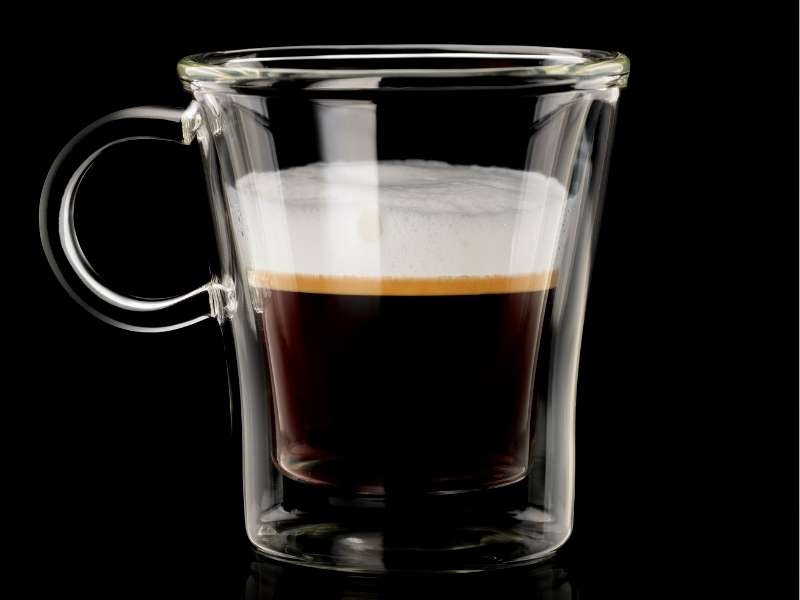
The main difference between a macchiato and a latte is the amount of milk. Both drinks feature espresso, but while both the latte and cappuccino involve large quantities of milk, the macchiato does not.
Translated, ‘macchiato’ means ‘mark,’ or ‘stain’. It refers to the jot of foamed milk that gets added to the macchiato; Enough to give it some color but not enough to overwhelm the drink.
Italian tradition has it that the macchiato is best drunk at breakfast, because large quantities of milk on a full stomach don’t make for a balanced meal. A demitasse of macchiato – that’s roughly 3-4 oz – is just enough caffeine and milk both to kickstart the day.
Latte Macchiato
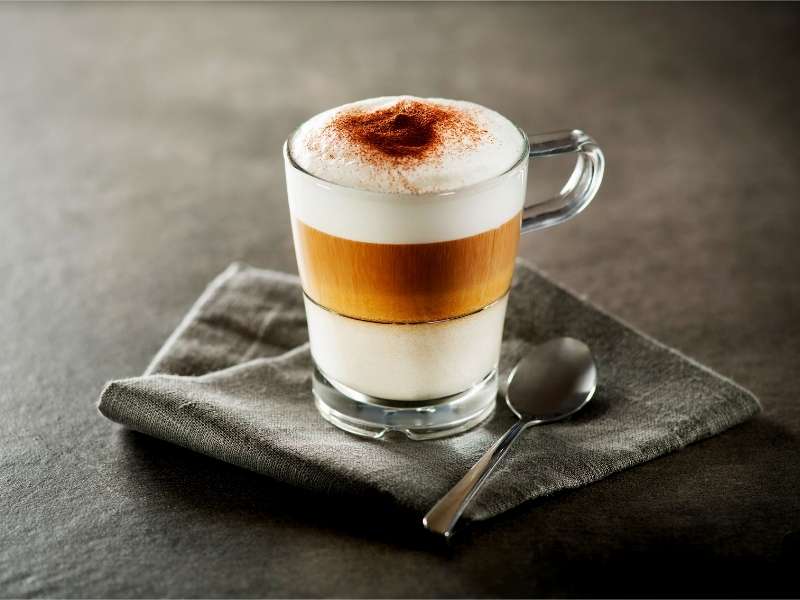
Ever adaptable, though, the macchiato has since developed a milkier cousin, dubbed the latte macchiato. If the macchiato is espresso marked with milk, then the reverse is true here.
The latte macchiato combines the milkiness of the latte with the marking dollop of the macchiato. And whereas in a latte, milk is added to espresso, in a latte macchiato espresso is added to milk.
Here the milk is steamed until velvety, and only then is the shot of espresso added, creating a coffee mark on the creamy drink. These latte macchiatos are sometimes affectionately called macchia.
Everyone knows there’s an ongoing debate among tea drinkers about whether the milk goes in first or last.
When preparing a latte, the milk and foam sit serenely atop the espresso. But in making a macchiato, the coffee-maker adds a generous portion of espresso to a minimal amount of milk.
Simply put, ingredients for a macchiato include:
- A single or double espresso shot
- A dollop of milk
Whereas the proportions for a latte are:
- One third espresso
- Two-thirds milk
- Approximately 1 cm foam
One of the critical differences between the macchiato and the latte is the strength of the drink. Because much less milk goes into a macchiato, it is a much more caffeinated drink.
That said, the macchiato from, for instance, Starbucks, with options for extra milk and shots of syrup, is much closer to the latte than its more traditional Italian equivalent.
What is the Difference Between a Latte and Coffee?
Strictly speaking, the coffee and espresso beans aren’t different beans. They’re just prepared differently. This is key to understanding the difference between coffee and lattes. While coffee is made from the coffee bean and brewed over time, a latte is made from espresso beans.
Espresso beans are both more densely packed and more highly pressurized in the preparation process. The resultant drink is a darker, bolder tasting beverage, and it’s a shot of this aromatic espresso that forms the basis of a latte.
Coffee Latte

Drink permutations being endlessly malleable, the coffee latte has since emerged on the culinary scene. Even though the traditional latte uses espresso for a caffeine base, the coffee latte uses coffee.
The coffee latte also features steamed milk, and a little foam, making it more than your average milky coffee. It’s milder in taste and preferable if you don’t like the potency of espresso.
Latte vs Tea Latte
Lattes have come a long way since the 17th century and are now regularly served with a range of additional flavors, sweeteners, and milk options. And one of those options is tea. If you have no taste for coffee, but love milky drinks, the tea latte is the drink for you.
The tea latte combines the richness of the caffe latte with the tannin of tea. For best effect, it’s made using matcha green tea, a potent green tea that serves as a handy substitute for espresso.
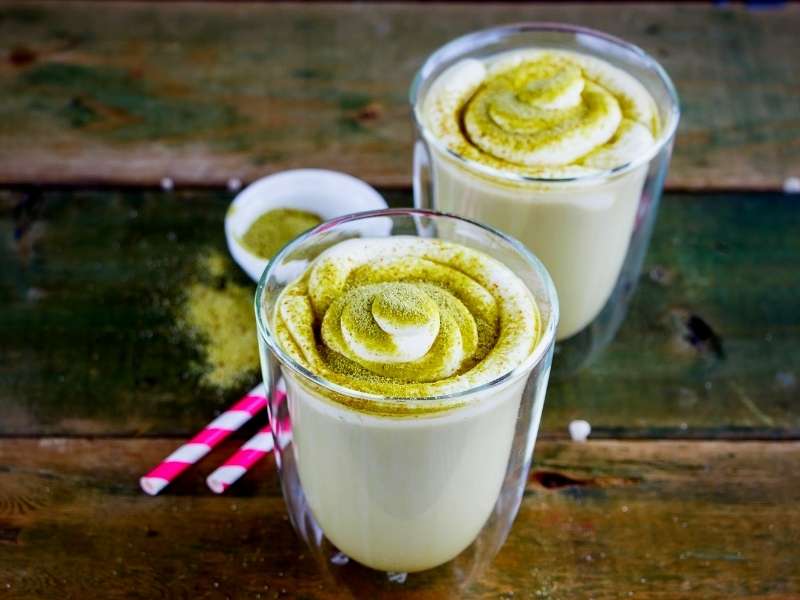
Kashmiri chai is another popular contender when making a tea latte. But as with any latte, the tea latte is highly customizable, allowing the drinker to blend their favorite tea with steamed milk of their choice.
But while some fruity teas curdle in milk, others, like Milk Oolong, can pair beautifully with it. So for an enjoyable tea latte experience, a bit of circumspection and careful evaluation is worthwhile.
How to Make a Latte
There are several different types of lattes, each having its own individual recipe. If you’d like to experiment with different lattes, some of the most popular are:
- Blonde latte
- Vanilla latte
- Skinny latte
- Cafe latte
- Busch latte
- Golden latte
While North Americans steam the milk for their lattes, that’s not the only way to make a latte. Purists following the Italian preparation will instead brew their espresso in a stovetop pot. And instead of steaming the milk, as is popular, you may heat it on the stove until it’s ready for use.
There’s no reason not to make a latte in the privacy of your own home. The process isn’t complicated. Not least because with the advent of the espresso machine, lattes are more accessible than ever.
To make a standard latte:
- Gently heat milk
- Lightly whisk until it froths
- Brew espresso and pour 1/3 of a cup into a latte cup
- Pour 2/3 of a cup of milk, holding back foam
- Ladle foam onto the top of the latte
- Sweeten to taste
- Enjoy!
Now that you know everything about lattes start experimenting with making your own or sampling different types! Do you have a better latte recipe? Let us know in the comments!
